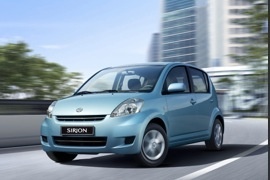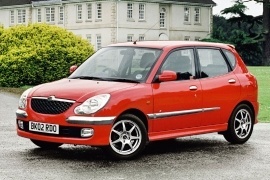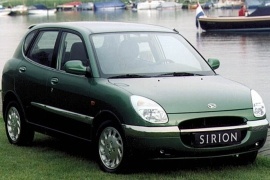
DAIHATSU Sirion
Generations Timeline, Specs and Pictures

Daihatsu designed the 2004 Sirion for the European market, and six years later, it came with a refreshed version that should increase its sales.
Toyota held a major part of Daihatsu’s stakes since 1998, and it helped the small carmaker to make better vehicles, fit for other markets than Japan’s. The Sirion was part of the company’s program to expand in Europe with small-sized vehicles that were more affordable than the Yaris. The 2004 Sirion, with its strange design, started to get traction on the market until 2007 when it managed to sell almost 60.000 units. But then, due to the world financial crisis, the sales dropped. The facelifted Sirion should save the company from its continuous decline in sales.
Small-sized, with slightly curved body panels and flared wheel-arches, the Sirion tried to look sportier than its engine or chassis could handle. Daihatsu changed its headlights with clear-lens ones. Its bumper looked like it was ready to tackle a race track or, due to its round fog-lights mounted on the outer sides, a rally stage. It even featured a roof-spoiler on the top of its vertical tailgate.
Inside, Daihatsu’s designers made an oval instrument cluster with an unusual dial display, where the tachometer took the left side, and the speedometer described an arched line over a center-mounted LCD. Each door-card carried a cup-holder, which was also unusual for European customers. The seats were tall to make more legroom. The rear passengers could have slid their feet under the front seats.
Under the hood, the Sirion received a 1.0-liter three-cylinder engine from Toyota. It was the only option they could get and comply with the European emission regulations, and only with a manual transmission.

Daihatsu introduced the Sirion on the market in 1998 and refreshed it three years later, but without too much success to the public.
Toyota owned the Daihatsu brand, one of the oldest Japanese internal combustion engine manufacturers. A brand which was known on its home market for producing kei-cars and tricycles. But its parent company thought that it might be a good idea to offer Daihatsu as a sub-brand with more affordable vehicles. Unfortunately, that parent company didn’t care about the design department. So, Daihatsu made the Sirion in 1998 and launched it on the market in the small segment. Later on, it introduced a facelifted version.
From the outside, the car looked bland despite its retro-styling. The rounded, then swept-back headlights with a small added lamp on the inner side looked like they were designed after the entire vehicle was ready to roll. A black grille was cut into the front bumper. From its sides, the only interesting part was the third window behind the rear doors. Other than that, it was a biodesign example that didn’t fit in the market anymore. As the last scream for attention, the Sirion sported a chromed line on the sides complemented by chromed door handles.
Inside, the car was surprisingly spacious, and that was the main reason people bought it despite its higher price than a Ford Fiesta. Inside, Toyota insisted that the car should offer a few standard features such as the air conditioning and the front power-windows. As for the materials used, that’s another story.
Under the hood, Daihatsu installed its 1.0-liter, 3-cylinder engine for the base model and a 1.3-liter, inline-four, carried over from the Yaris.

Daihatsu’s expertise in small cars was obvious, and it introduced the Sirion in 1998 as a sub-compact segment vehicle and exported it from Japan.
Even though the Charade name was better-known, Daihatsu made a bold decision and changed the lineup name instead of just call it a new generation. But it was more than just a new model; it was a new concept. The car aimed to a higher level, with better-equipped vehicles. It wasn’t just a box on the wheels anymore, or, at least, it tried not to.
Daihatsu was slow in the decision to implement the bio-design trend on its lineup, but the Sirion adopted it. It featured tear-shaped, swept-back headlights with the turn signals mounted on their upper sides. A rounded grille crossed by a horizontal slat filled most of the area between the headlamps, and the carmaker found a way to install two fog lights on the lower side of the bumper. From its sides, the Sirion surprised the customers with its curved ascending beltline over the rear doors and the last row of windows placed behind them. In the back, the sub-compact car featured similar tear-shaped taillights as the headlights.
Inside, the Sirion offered room for four adults, ending the “fourish” roominess of the Charade’s interiors. The dashboard was clearly a big step forward with an advanced design. Its instrument panel and center stack shared the same cover that continued on the passenger’s side with an open storage area. Since Daihatsu was part of the Toyota Motor Corporation, it took some ideas from its bigger brother and installed the climate controls above the stereo.
Under the hood, the carmaker installed a choice of two engines, both running on gasoline. Daihatsu paired them with a five-speed manual gearbox.























































